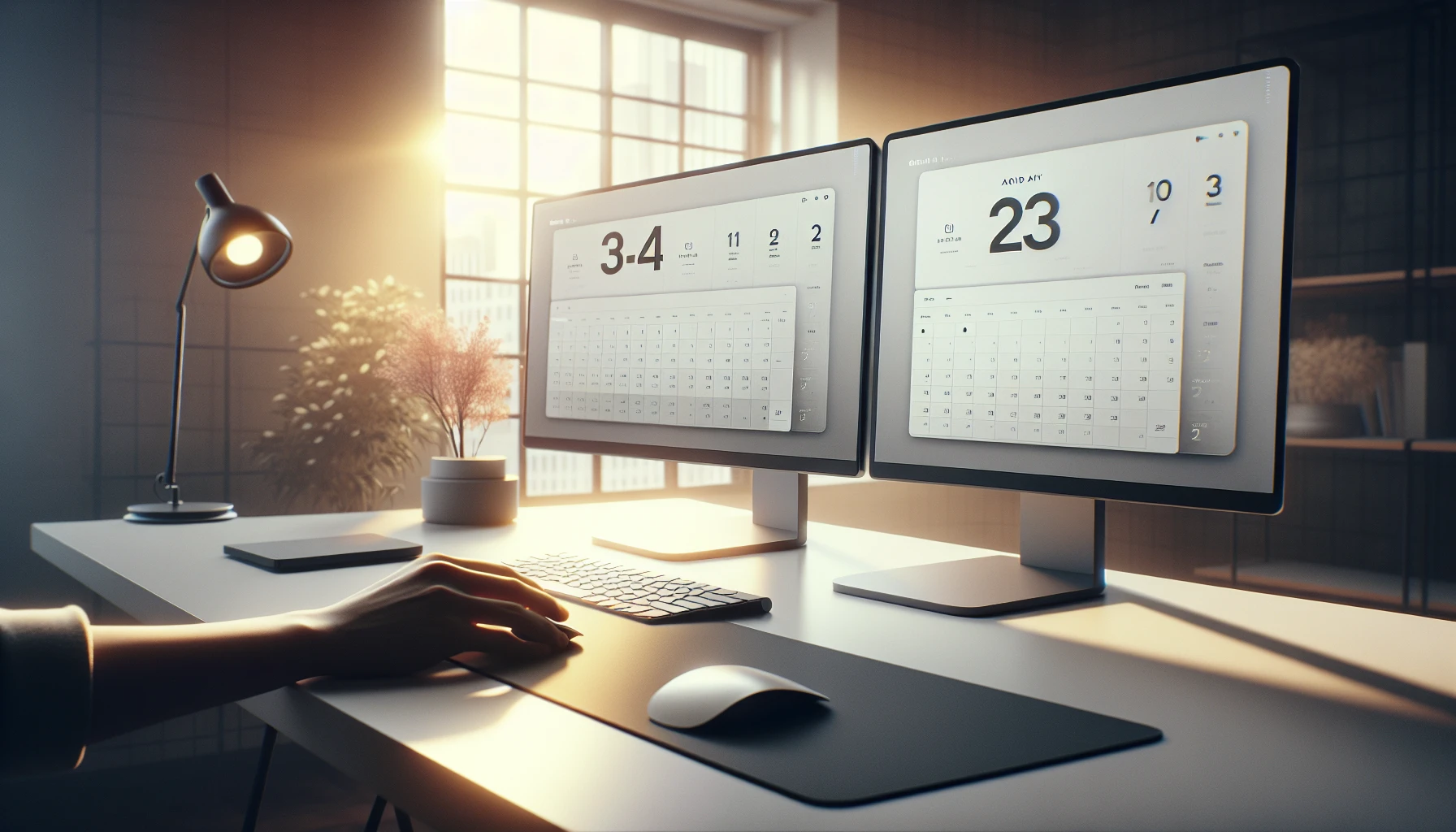· Ricardo Batista · 13 min read
Free Meeting Scheduler - How to plan meetings fast
Free meeting schedulers ease meetup planning with reminders, calendar sync and simple steps to book events using Calendly and Teams.

Looking for a way to organize your meetings without too much hassle? This article shows you some cool tools that make scheduling fun and easy using simple steps and neat tricks to manage calls and appointments. We talk about popular picks that sync calendars and work with other tools, and share tips to help set up your scheduler just right.
Key Takeaways
- Using a free meeting scheduler helps you keep your schedule in order and makes it way easier to book time.
- These tools sync with calendars like Google and Outlook so you won’t have overlapping meetings.
- They let you set up quick notifications that automatically ping attendees who arrive late to your meetings, showing our expertise in making meetings run smoother.
- Integrations with apps like Calendly and Microsoft Teams simplify your work and cut down on manual tasks.
- Overall, adopting these tools saves you time and keeps your day running a bit more organized and relaxed.
Understanding Free Meeting Schedulers
Free meeting schedulers are handy tools that let you set up appointments without the usual back-and-forth exchanging of emails. These platforms not only manage bookings but also send automated meeting reminders—ensuring that no one shows up late without a heads-up. They cater especially to busy folks who need to keep every meeting on track, often with automatic notifications to those who might otherwise forget or be tardy.
These tools are a revolution compared to traditional scheduling. They help streamline your calendar, reduce miscommunication, and improve punctuality. With features such as automated pinging of late attendees, you minimize disruption to ongoing meetings and keep everyone informed. In today’s fast-paced digital world, a free meeting scheduler that integrates with various apps can really empower your workflow.
Key Features of Top Free Tools
When looking at the market, there are a few standout features that you should consider. Many free tools offer unique capabilities beyond simple scheduling, and knowing these can help you decide which one best fits your needs.
Calendly
Calendly has gained popularity because of its clean interface and seamless integration options. It provides various appointment types, letting you differentiate between quick check-ins and in-depth meetings. With Calendly, you can:
- Set event types with specific meeting durations.
- Sync your calendar with external platforms to avoid double-booking.
- Automatically send reminders to attendees who might arrive late.
Calendly’s easy-to-use platform means you can quickly find time slots that work for everyone. Its integration with other calendar apps simplifies the process drastically, reducing the hassle of manual updates.
When2Meet
When2Meet is another free option that offers a more interactive way of finding mutually convenient meeting times. Instead of instantly booking a slot, it lets all participants mark their available times on a shared grid. This tool is especially useful for group meetings where participants come from different time zones or have varied schedules. Key functionalities include:
- A visual grid to identify overlapping free times.
- No need for account creation, which keeps things frictionless when coordinating with a large group.
- An emphasis on collaboration, promoting group consensus on meeting times.
Integrations with Microsoft Teams and Zapier
Beyond standalone scheduling, integration with other productivity tools is essential. Microsoft Teams, for instance, is well-known for its robust communication features. By linking your scheduler with Microsoft Teams, you can automatically create virtual meeting links as soon as a slot is booked. This minimizes extra steps for both hosts and participants, particularly when it comes to last-minute changes.
Similarly, Zapier acts as a bridge between different apps, automating repetitive tasks. With Zapier, you can create workflows that automatically update your CRM, send follow-up emails, or sync contact information across platforms once a meeting is confirmed. This level of automation ensures that all your digital tools work in harmony, saving time and reducing errors.
Practical Use Cases and Integrations
Beyond the seamless booking and syncing of meetings, free meeting schedulers offer numerous practical applications that can boost overall efficiency.
Booking and Calendar Sync
One of the primary benefits of free meeting schedulers is their ability to streamline the booking process. Instead of endless email threads, you can simply direct your attendees to pick times that work for them. The automatic calendar sync works in real time, ensuring that any updates or cancellations are propagated instantly across all linked devices and platforms.
Consider these specific scenarios:
- When booking client appointments, both your and your client’s calendars are automatically updated, reducing the risk of overlapping meetings.
- For internal team meetings, the scheduler can automatically send reminders to team members, highlighting who might be a few minutes late.
- The visual tools provided by both Calendly and When2Meet help you see patterns in busy times, so you can plan better for team availability.
The integration capabilities also allow you to use tools like SurveyMonkey and Picktime to extend the scheduling experience. For example, you can embed a SurveyMonkey form into the booking confirmation page to gather additional details or feedback about the upcoming meeting. Meanwhile, Picktime templates can provide a structured agenda for your meeting, ensuring that every minute is used effectively.
Automated Meeting Reminders
One of the standout features that can really improve punctuality is the automated meeting reminder. These are not just scheduled notifications; they adapt to the behavior of participants. For instance, if someone frequently joins late, some schedulers can be set up to send a gentle nudge or a ping to remind them before the meeting starts. Automated meeting reminders can include:
- Customizable text messages that let recipients know exactly what to do if they’re delayed.
- Follow-up notifications that confirm attendance once the meeting begins.
- Integration with communication apps like WhatsApp, which some users may prefer over email or SMS. You can explore tools like the Free Whatsapp Reminder to add extra layers of communication reliability.
Setting up these reminders usually takes just a few clicks within the scheduler’s settings menu. They can be customized to trigger a set number of minutes before the meeting or even immediately after a scheduled start time if someone hasn’t joined. You might also want to consider a schedule reminder tool for more robust options. This whole workflow minimizes wasted time and ensures that the meeting kicks off exactly when it’s supposed to.
Enhancing Workflow with Additional Tools
There are a range of supplemental tools that, when integrated with your free meeting scheduler, help smooth out the entire process. Integrations with platforms like SurveyMonkey and Picktime show how these tools can be tailored to your specific needs. Using a SurveyMonkey form during the scheduling process, for example, allows you to quickly collect information that might influence the meeting agenda or necessary preparations. Picktime templates, on the other hand, let you incorporate pre-set agendas to keep your discussions focused and on track.
Meeting schedulers often integrate with other digital tools too. For instance:
- Syncing with CRM systems ensures that client interactions are logged and followed up after the meeting.
- Built-in video conferencing links created automatically via Microsoft Teams reduce the friction of starting an online meeting.
- Automated email workflows configured through Zapier cut down on manual entries and follow-ups, ensuring reminders are timely.
If you’re looking for more ideas on optimizing your notifications, you might find the insights on the Best Free Reminder App useful. These tools provide models that show exactly how automated reminders can be set up to suit varying needs. Also, check out our guide on essential staff meeting reminder strategies.
Setting Up and Optimizing Your Meeting Scheduler
Getting started with a free meeting scheduler is often straightforward, yet optimizing it for your specific workflow takes a bit of tweaking. The following step-by-step guide can help you get set up quickly, with a particular focus on ensuring punctuality through meeting reminders.
Step-by-Step Setup
- Choose your scheduler: Decide which tool fits your needs better. If you prefer a visual approach with a grid layout, When2Meet is a great option. For more integrated workflow capabilities, Calendly may be the better choice.
- Create an account: Sign up for a free account on the chosen platform. Both Calendly and When2Meet have user-friendly registration processes that do not require too much information.
- Set up your calendar integration: Connect your existing calendar (such as Google Calendar or Outlook) so that availability is automatically updated. This ensures that you avoid double-booking or scheduling conflicts.
- Configure meeting types: Define the various types of meetings you regularly schedule. You might create different appointment slots for client consultations, team meetings, or internal reviews.
- Enable meeting reminders: Locate the meeting reminder settings in your scheduler’s interface. Customize the timing and message of your alerts. For example, set a reminder to go out 10 minutes before the meeting and another if attendees fail to join on time.
- Establish integrations: If you rely on video conferencing, look for options to add integrations with Microsoft Teams. Set up workflows in Zapier to automate additional tasks, such as sending follow-up emails after the meeting.
- Test the system: Before rolling it out to all meetings, run a test appointment to see that all reminders, calendar syncs, and integrations function as expected.
Optimizing Workflow for Different Needs
Different work scenarios may call for additional adjustments beyond the standard setup. Here are a few ideas on how to fine-tune your meeting scheduler for various purposes:
- Remote teams: When you manage a remote team, consider scheduling daily or weekly check-ins. Use the scheduler’s option to send late-arrival notifications so that if someone joins the meeting late, a reminder on punctuality can be issued automatically.
- Client engagement: For client meetings, integrate a SurveyMonkey form during booking to capture specific topics or questions they might have. This step can help you prepare better and streamline the meeting agenda.
- Event planning: Use the scheduler to manage large group sessions. When many attendees are involved, a visual availability grid like that offered by When2Meet helps in selecting the best time slot. Additionally, automated follow-up reminders ensure that everyone gets the meeting link on time.
- Educational settings: Educators or trainers can use the meeting scheduler to plan classes or webinars. You can set up recurring sessions and provide automated links to join. This is particularly useful when dealing with learners across different time zones.
Fine-Tuning Meeting Reminders
Optimizing meeting reminders can increase overall meeting discipline and reduce wasted time. Follow these additional adjustments to make your reminders as effective as possible:
Customize messages: Use plain language that resonates with your audience, making the reminder sound friendly yet firm. Include relevant details such as the meeting start time, a link to join, and a note about the importance of punctuality.
Stagger reminders: Instead of sending a single reminder, schedule multiple notifications. For example, one reminder at 15 minutes prior and another at the scheduled start if participants haven’t joined.
Monitor response patterns: Check your meeting reports to see if the reminder settings are effective. If a particular group is consistently late, consider adjusting the timing or content of the alerts to better capture their attention.
Integrate supplementary tools: Consider integrating additional reminder systems like WhatsApp notifications. Tools such as the Free Whatsapp Reminder can serve as a backup to your email or SMS alerts. This dual-channel approach works well if your attendees have a preference for WhatsApp notifications over conventional methods.
Use automation workflows: Set up Zapier to trigger follow-up actions if a meeting starts late due to lateness. This might include sending a quick link for participants to update their status or even logging the delay for future reference.
Maintaining a Streamlined Setup
Once your scheduler is up and running, periodic reviews can help you maintain an efficient system:
- Review calendar conflicts: Regularly update your calendar integrations to keep track of new meetings and avoid overlaps.
- Update message templates: Refresh your meeting reminder messages every few months to keep them relevant and effective.
- Adjust integration settings: As your workflow evolves, you might find that your integration needs change. Check Microsoft Teams and Zapier settings periodically to ensure they match your current scheduling habits.
- Solicit feedback: Ask meeting participants for feedback on the scheduling and reminder process. Quick surveys can help pinpoint pain points and see if reminders are truly helping maintain meeting punctuality.
Employing these strategies helps transform a free meeting scheduler into a dynamic hub of organization and communication, where every meeting is backed by effective planning and timely alerts. The combination of easy booking, calendar syncing, and reliable automated reminders creates a seamless experience that benefits everyone, whether working in a startup environment or a larger organization.
Free meeting schedulers not only save time but also encourage a culture of punctuality by automatically pinging attendees who might be consistently late. As you experiment with different features and integrations, you’ll likely find new ways to optimize your workflow. With a bit of setup and ongoing adjustments, your scheduler becomes a powerful tool that supports smooth operations and improved meeting outcomes.
Conclusion
In this article we dug into the world of free meeting schedulers and how they simplify planning. We learned that using the right tools, like Calendly and Microsoft Teams, can save time and make organizing meetings easier. The simple tips we shared show that syncing calendars, setting up automated reminders and integrating useful apps are key to managing your time better. Sure, it might seem like a lot at first, but taking one step at a time helps link everything together neatly.
Another important takeaway is that finding a tool that fits your workflow is essential and a bit of trial and error goes a long way. Our discussion also showed how neat it is when tools like survey forms or Picktime come together for a smoother scheduling process.
If you often find managers dealing with late arrivals and wasted time, let our expertise step in. Meeting Reminders can help by automatically pinging attendees who arrive late to your meetings. So, go ahead, try out these techniques, and start making your meeting setup work smarter for you.
Related Posts
Frequently Asked Questions (FAQs)
How does a free meeting scheduler work?
A free meeting scheduler helps you set up meeting times quickly by letting people pick from available slots. It also sends reminders and updates so you don’t have to worry about double bookings
Can a free meeting scheduler sync with my calendar?
Yes, most free meeting schedulers can automatically sync with calendars like Google and Outlook. This prevents overlaps and makes it simple to keep everything organized
Are free meeting schedulers secure?
They generally use encryption and follow security guidelines to protect your data but it’s always a good idea to check the specific privacy policies of each scheduler to make sure it suits your needs
How can I use Meeting Reminders to automatically ping attendees that arrive late to your meetings?
Meeting Reminders has a neat feature that sends a ping or alert to attendees who show up late. This can help keep meetings running on time and reduce delays. You might want to try out their service at Meeting Reminders to see how it works for you
Do free meeting schedulers support integrations with other tools?
Many do, yes. Tools like Zapier bring integration with other apps so you can link your scheduler to CRMs, email clients and more making your scheduling process smoother and more connected



